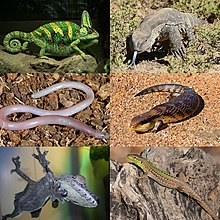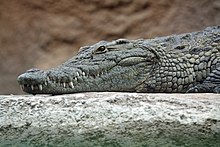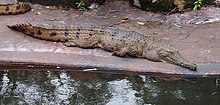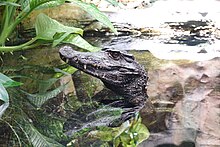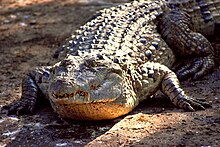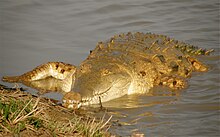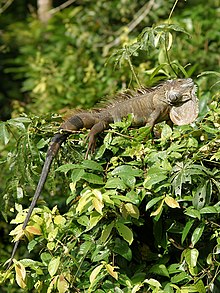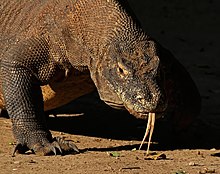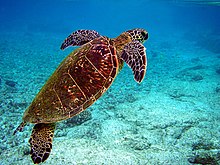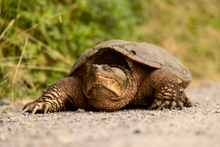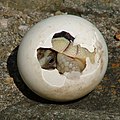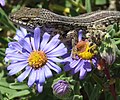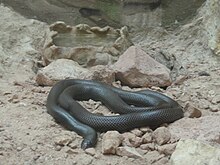Template:Transclude excerpts as random slideshow/testcases/Portal:Reptiles
Portal maintenance status: (June 2018)
|
Inroduction
Reptiles, as commonly defined, are a group of tetrapods with an ectothermic ('cold-blooded') metabolism and amniotic development. Living traditional reptiles comprise four orders: Testudines (turtles), Crocodilia (crocodilians), Squamata (lizards and snakes), and Rhynchocephalia (the tuatara). As of May 2023, about 12,000 living species of reptiles are listed in the Reptile Database. The study of the traditional reptile orders, customarily in combination with the study of modern amphibians, is called herpetology.
Reptiles have been subject to several conflicting taxonomic definitions. In Linnaean taxonomy, reptiles are gathered together under the class Reptilia (/rɛpˈtɪliə/ rep-TIL-ee-ə), which corresponds to common usage. Modern cladistic taxonomy regards that group as paraphyletic, since genetic and paleontological evidence has determined that birds (class Aves), as members of Dinosauria, are more closely related to living crocodilians than to other reptiles, and are thus nested among reptiles from an evolutionary perspective. Many cladistic systems therefore redefine Reptilia as a clade (monophyletic group) including birds, though the precise definition of this clade varies between authors. Others prioritize the clade Sauropsida, which typically refers to all amniotes more closely related to modern reptiles than to mammals.
The earliest known proto-reptiles originated from the Carboniferous period, having evolved from advanced reptiliomorph tetrapods which became increasingly adapted to life on dry land. The earliest known eureptile ("true reptile") was Hylonomus, a small and superficially lizard-like animal which lived in Nova Scotia during the Bashkirian age of the Late Carboniferous, around 318 million years ago. Genetic and fossil data argues that the two largest lineages of reptiles, Archosauromorpha (crocodilians, birds, and kin) and Lepidosauromorpha (lizards, and kin), diverged during the Permian period. In addition to the living reptiles, there are many diverse groups that are now extinct, in some cases due to mass extinction events. In particular, the Cretaceous–Paleogene extinction event wiped out the pterosaurs, plesiosaurs, and all non-avian dinosaurs alongside many species of crocodyliforms and squamates (e.g., mosasaurs). Modern non-bird reptiles inhabit all the continents except Antarctica. (Full article...)
Reptile types
-
Image 1
The gharial (Gavialis gangeticus), also known as gavial or fish-eating crocodile, is a crocodilian in the family Gavialidae and among the longest of all living crocodilians. Mature females are 2.6 to 4.5 m (8 ft 6 in to 14 ft 9 in) long, and males 3 to 6 m (9 ft 10 in to 19 ft 8 in). Adult males have a distinct boss at the end of the snout, which resembles an earthenware pot known as a ghara, hence the name "gharial". The gharial is well adapted to catching fish because of its long, narrow snout and 110 sharp, interlocking teeth.
The gharial probably evolved in the northern Indian subcontinent. Fossil gharial remains were excavated in Pliocene deposits in the Sivalik Hills and the Narmada River valley. It currently inhabits rivers in the plains of the northern part of the Indian subcontinent. It is the most thoroughly aquatic crocodilian, and leaves the water only for basking and building nests on moist sandbanks. Adults mate at the end of the cold season. Females congregate in spring to dig nests, in which they lay 20–95 eggs. They guard the nests and the young, which hatch before the onset of the monsoon. The hatchlings stay and forage in shallow water during their first year, but move to sites with deeper water as they grow.
The wild gharial population has declined drastically since the 1930s and is limited to only 2% of its historical range today. Conservation programmes initiated in India and Nepal focused on reintroducing captive-bred gharials since the early 1980s. Loss of habitat because of sand mining and conversion to agriculture, depletion of fish resources and detrimental fishing methods continue to threaten the population. It has been listed as critically endangered on the IUCN Red List since 2007. (Full article...) -
Image 2An American alligator (top) and a Chinese alligator
An alligator, or colloquially gator, is a large reptile in the genus Alligator of the family Alligatoridae in the order Crocodilia. The two extant species are the American alligator (A. mississippiensis) and the Chinese alligator (A. sinensis). Additionally, several extinct species of alligator are known from fossil remains. Alligators first appeared during the late Eocene epoch about 37 million years ago.
The term "alligator" is likely an anglicized form of el lagarto, Spanish for "the lizard", which early Spanish explorers and settlers in Florida called the alligator. Early English spellings of the name included allagarta and alagarto. (Full article...) -
Image 3Clockwise from top left: veiled chameleon (Chamaeleo calyptratus), rock monitor (Varanus albigularis), common blue-tongued skink (Tiliqua scincoides), Italian wall lizard (Podarcis sicula), giant leaf-tailed gecko (Uroplatus fimbriatus), and legless lizard (Anelytropsis papillosus)
Lizard is the common name used for all squamate reptiles other than snakes (and to a lesser extent amphisbaenians), encompassing over 7,000 species, ranging across all continents except Antarctica, as well as most oceanic island chains. The grouping is paraphyletic as some lizards are more closely related to snakes than they are to other lizards. Lizards range in size from chameleons and geckos a few centimeters long to the 3-meter-long Komodo dragon.
Most lizards are quadrupedal, running with a strong side-to-side motion. Some lineages (known as "legless lizards") have secondarily lost their legs, and have long snake-like bodies. Some lizards, such as the forest-dwelling Draco, are able to glide. They are often territorial, the males fighting off other males and signalling, often with bright colours, to attract mates and to intimidate rivals. Lizards are mainly carnivorous, often being sit-and-wait predators; many smaller species eat insects, while the Komodo eats mammals as big as water buffalo.
Lizards make use of a variety of antipredator adaptations, including venom, camouflage, reflex bleeding, and the ability to sacrifice and regrow their tails. (Full article...) -
Image 4
Turtles are reptiles of the order Testudines, characterized by a special shell developed mainly from their ribs. Modern turtles are divided into two major groups, the Pleurodira (side necked turtles) and Cryptodira (hidden necked turtles), which differ in the way the head retracts. There are 360 living and recently extinct species of turtles, including land-dwelling tortoises and freshwater terrapins. They are found on most continents, some islands and, in the case of sea turtles, much of the ocean. Like other amniotes (reptiles, birds, and mammals) they breathe air and do not lay eggs underwater, although many species live in or around water.
Turtle shells are made mostly of bone; the upper part is the domed carapace, while the underside is the flatter plastron or belly-plate. Its outer surface is covered in scales made of keratin, the material of hair, horns, and claws. The carapace bones develop from ribs that grow sideways and develop into broad flat plates that join up to cover the body. Turtles are ectotherms or "cold-blooded", meaning that their internal temperature varies with their direct environment. They are generally opportunistic omnivores and mainly feed on plants and animals with limited movements. Many turtles migrate short distances seasonally. Sea turtles are the only reptiles that migrate long distances to lay their eggs on a favored beach.
Turtles have appeared in myths and folktales around the world. Some terrestrial and freshwater species are widely kept as pets. Turtles have been hunted for their meat, for use in traditional medicine, and for their shells. Sea turtles are often killed accidentally as bycatch in fishing nets. Turtle habitats around the world are being destroyed. As a result of these pressures, many species are extinct or threatened with extinction. (Full article...) -
Image 5
The tuatara (Sphenodon punctatus) is a species of reptile endemic to New Zealand. Despite its close resemblance to lizards, it is part of a distinct lineage, the order Rhynchocephalia. The name tuatara is derived from the Māori language and means "peaks on the back".
The single extant species of tuatara is the only surviving member of its order, which was highly diverse during the Mesozoic era. Rhynchocephalians first appeared in the fossil record during the Triassic, around 240 million years ago, and reached worldwide distribution and peak diversity during the Jurassic, when they represented the world's dominant group of small reptiles. Rhynchocephalians declined during the Cretaceous, with their youngest records outside New Zealand dating to the Paleocene. Their closest living relatives are squamates (lizards and snakes). Tuatara are of interest for studying the evolution of reptiles.
Tuatara are greenish brown and grey, and measure up to 80 cm (31 in) from head to tail-tip and weigh up to 1.3 kg (2.9 lb) with a spiny crest along the back, especially pronounced in males. They have two rows of teeth in the upper jaw overlapping one row on the lower jaw, which is unique among living species. They are able to hear, although no external ear is present, and have unique features in their skeleton. (Full article...) -
Image 6Aldabra giant tortoise
(Aldabrachelys gigantea)
Tortoises (/ˈtɔːrtəs.ɪz/ TOR-təs-iz) are reptiles of the family Testudinidae of the order Testudines (Latin for "tortoise"). Like other turtles, tortoises have a shell to protect from predation and other threats. The shell in tortoises is generally hard, and like other members of the suborder Cryptodira, they retract their necks and heads directly backward into the shell to protect them.
Tortoises can vary in size with some species, such as the Galápagos giant tortoise, growing to more than 1.2 metres (3.9 ft) in length, whereas others like the Speckled cape tortoise have shells that measure only 6.8 centimetres (2.7 in) long. Several lineages of tortoises have independently evolved very large body sizes in excess of 100 kilograms (220 lb), including the Galapagos giant tortoise and the Aldabra giant tortoise. They are usually diurnal animals with tendencies to be crepuscular depending on the ambient temperatures. They are generally reclusive animals. Tortoises are the longest-living land animals in the world, although the longest-living species of tortoise is a matter of debate. Galápagos tortoises are noted to live over 150 years, but an Aldabra giant tortoise named Adwaita may have lived an estimated 255 years. In general, most tortoise species can live 80–150 years.
Tortoises are placid and slow-moving, with an average walking speed of 0.2–0.5 km/h.[citation needed] (Full article...) -
Image 7Yacare caiman, Caiman yacare
A caiman (/ˈkeɪmən/ (also spelled cayman) from Taíno kaiman[additional citation(s) needed]) is an alligatorid belonging to the subfamily Caimaninae, one of two primary lineages within the Alligatoridae family, the other being alligators. Caimans are native to Central and South America and inhabit marshes, swamps, lakes, and mangrove rivers. They have scaly skin and live a fairly nocturnal existence. They are relatively small-sized crocodilians with an average maximum weight of 6 to 40 kg (13 to 88 lb) depending on species, with the exception of the black caiman (Melanosuchus niger), which can grow more than 4 m (13 ft) in length and weigh in excess of 450 kg (1,000 Ib). The black caiman is the largest caiman species in the world and is found in the slow-moving rivers and lakes that surround the Amazon basin. The smallest species is the Cuvier's dwarf caiman (Paleosuchus palpebrosus), which grows to 1.2 to 1.5 m (3.9 to 4.9 ft) long. There are six different species of caiman found throughout the watery jungle habitats of Central and Southern America. The average length for most of the other caiman species is about 2 to 2.5 m (6.6 to 8.2 ft) long.
Caimans are distinguished from alligators, their closest relatives, by a few defining features: a lack of a bony septum between the nostrils, ventral armor composed of overlapping bony scutes formed from two parts united by a suture, and longer and sharper teeth than alligators, plus caimans tend to be more agile and crocodile-like in their movements. The calcium rivets on caiman scales make their hides stiffer.
Several extinct forms are known, including Purussaurus, a giant Miocene genus that grew to 12 m (39 ft) and the equally large Mourasuchus, which had a wide duck-like snout. (Full article...) -
Image 8Nile crocodile (Crocodylus niloticus)
Crocodiles (family Crocodylidae) or true crocodiles are large, semiaquatic reptiles that live throughout the tropics in Africa, Asia, the Americas and Australia. The term “crocodile” is sometimes used more loosely to include all extant members of the order Crocodilia, which includes the alligators and caimans (both members of the family Alligatoridae), the gharial and false gharial (both members of the family Gavialidae) as well as other, extinct, taxa.
Although crocodiles, alligators, and the gharial are similar in appearance, they belong to separate biological families. The gharial, with its narrow snout, is easier to distinguish, while morphological differences are more difficult to spot in crocodiles and alligators. The most obvious external differences are visible in the head, with crocodiles having narrower and longer heads, with a more V-shaped than a U-shaped snout compared to alligators and caimans. Another obvious trait is that the upper and lower jaws of the crocodiles are the same width, and the teeth in the lower jaw fall along the edge or outside the upper jaw when the mouth is closed; therefore, all teeth are visible, unlike an alligator, which possesses in the upper jaw small depressions into which the lower teeth fit. Also, when the crocodile's mouth is closed, the large fourth tooth in the lower jaw fits into a constriction in the upper jaw. For hard-to-distinguish specimens, the protruding tooth is the most reliable feature to define the species' family. Crocodiles have more webbing on the toes of the hind feet and can better tolerate saltwater due to specialized salt glands for filtering out salt, which are present, but non-functioning, in alligators. Another trait that separates crocodiles from other crocodilians is their much higher levels of aggression.
Crocodile size, morphology, behaviour and ecology differ somewhat among species. However, they have many similarities in these areas as well. All crocodiles are semiaquatic and tend to congregate in freshwater habitats such as rivers, lakes, wetlands and sometimes in brackish water and saltwater. They are carnivorous animals, feeding mostly on vertebrates such as fish, reptiles, birds and mammals, and sometimes on invertebrates such as molluscs and crustaceans, depending on species and age. All crocodiles are tropical species that, unlike alligators, are very sensitive to cold. They separated from other crocodilians during the Eocene epoch, about 55 million years ago. Many species are at the risk of extinction, some being classified as critically endangered. (Full article...) -
Image 9Blanus cinereus, Spain
Amphisbaenia /æmfɪsˈbiːniə/ (called amphisbaenians or worm lizards) is a group of typically legless lizards, comprising over 200 extant species. Amphisbaenians are characterized by their long bodies, the reduction or loss of the limbs, and rudimentary eyes. As many species have a pink body and scales arranged in rings, they have a superficial resemblance to earthworms. While the genus Bipes retains forelimbs, all other genera are limbless. Phylogenetic studies suggest that they are nested within Lacertoidea, closely related to the lizard family Lacertidae. Amphisbaenians are widely distributed, occurring in North America, Europe, Africa, South America, Western Asia and the Caribbean. Most species are less than 6 inches (15 cm) long. (Full article...) -
Image 10
Snakes are elongated limbless reptiles of the suborder Serpentes (/sɜːrˈpɛntiːz/). Cladistically squamates, snakes are ectothermic, amniote vertebrates covered in overlapping scales much like other members of the group. Many species of snakes have skulls with several more joints than their lizard ancestors and relatives, enabling them to swallow prey much larger than their heads (cranial kinesis). To accommodate their narrow bodies, snakes' paired organs (such as kidneys) appear one in front of the other instead of side by side, and most have only one functional lung. Some species retain a pelvic girdle with a pair of vestigial claws on either side of the cloaca. Lizards have independently evolved elongate bodies without limbs or with greatly reduced limbs at least twenty-five times via convergent evolution, leading to many lineages of legless lizards. These resemble snakes, but several common groups of legless lizards have eyelids and external ears, which snakes lack, although this rule is not universal (see Amphisbaenia, Dibamidae, and Pygopodidae).
Living snakes are found on every continent except Antarctica, and on most smaller land masses; exceptions include some large islands, such as Ireland, Iceland, Greenland, and the islands of New Zealand, as well as many small islands of the Atlantic and central Pacific oceans. Additionally, sea snakes are widespread throughout the Indian and Pacific oceans. Around thirty families are currently recognized, comprising about 520 genera and about 3,900 species. They range in size from the tiny, 10.4 cm-long (4.1 in) Barbados threadsnake to the reticulated python of 6.95 meters (22.8 ft) in length. The fossil species Titanoboa cerrejonensis was 12.8 meters (42 ft) long. Snakes are thought to have evolved from either burrowing or aquatic lizards, perhaps during the Jurassic period, with the earliest known fossils dating to between 143 and 167 Ma ago. The diversity of modern snakes appeared during the Paleocene epoch (c. 66 to 56 Ma ago, after the Cretaceous–Paleogene extinction event). The oldest preserved descriptions of snakes can be found in the Brooklyn Papyrus.
Most species of snake are nonvenomous and those that have venom use it primarily to kill and subdue prey rather than for self-defense. Some possess venom that is potent enough to cause painful injury or death to humans. Nonvenomous snakes either swallow prey alive or kill by constriction. (Full article...)
Selected Crocodilia articles
-
Image 1

The Chinese alligator (Alligator sinensis; simplified Chinese: 鼍; traditional Chinese: 鼉; pinyin: tuó), also known as the Yangtze alligator (simplified Chinese: 扬子鳄; traditional Chinese: 揚子鱷; pinyin: yángzǐ'è), China alligator, or historically the muddy dragon, is a crocodilian endemic to China. It and the American alligator (A. mississippiensis) are the only living species in the genus Alligator of the family Alligatoridae. Dark gray or black in color with a fully armored body, the Chinese alligator grows to 1.5–2.1 metres (5–7 ft) in length and weighs 36–45 kilograms (80–100 lb) as an adult. It brumates in burrows in winter and is nocturnal in summer. Mating occurs in early summer, with females most commonly producing 20–30 eggs, which are smaller than those of any other crocodilian. The species is an opportunistic feeder, primarily eating fish and invertebrates. A vocal species, adults bellow during the mating season and young vocalize to communicate with their parents and other juveniles. Captive specimens have reached age 70, and wild specimens can live past 50.
Living in bodies of fresh water, the Chinese alligator's range is restricted to six regions in the province of Anhui, as well as possibly the provinces of Jiangsu and Zhejiang. Originally living as far away from its current range as Japan, the species previously had a wide range and population, but beginning in 6000 BC, multiple threats, such as habitat destruction, caused the species' population and range to decline. The population in the wild was about 1,000 in the 1970s, decreased to below 130 in 2001, and grew after 2003, with its population being about 300 as of 2017. Listed as critically endangered by the International Union for Conservation of Nature, multiple conservation actions have been taking place for this species.
The Chinese alligator has been a part of Chinese literature since the third century. In the late 13th century, Marco Polo became the first person outside of China to write about it. In some writings, the Chinese alligator has been associated with the Chinese dragon. Many pieces of evidence suggest that the Chinese alligator was an inspiration for the Chinese dragon. (Full article...) -
Image 2
The freshwater crocodile (Crocodylus johnstoni), also known commonly as the Australian freshwater crocodile, Johnstone's crocodile, and the freshie, is a species of crocodile native to the northern regions of Australia. Unlike its much larger Australian relative, the saltwater crocodile, the freshwater crocodile is not known as a man-eater, although it bites in self-defence, and brief, nonfatal attacks have occurred, apparently the result of mistaken identity. (Full article...) -
Image 3New Guinea crocodile at Bandung Zoo in West Java, Indonesia
The New Guinea crocodile (Crocodylus novaeguineae) is a small species of crocodile found on the island of New Guinea north of the mountain ridge that runs along the centre of the island. The population found south of the mountain ridge, formerly considered a genetically distinct population, is now considered a distinct species, Hall's New Guinea crocodile (C. halli). In the past it included the Philippine crocodile, C. n. mindorensis, as a subspecies, but today they are regarded as separate species. The habitat of the New Guinea crocodile is mostly freshwater swamps and lakes. It is most active at night when it feeds on fish and a range of other small animals. A female crocodile lays a clutch of eggs in a nest composed of vegetation and she lies up nearby to guard the nest. There is some degree of parental care for newly hatched juveniles. This crocodile was over-hunted for its valuable skin in the mid 20th century, but conservation measures have since been put in place, it is reared in ranches and the International Union for Conservation of Nature (IUCN) lists it as being of "Least Concern". (Full article...) -
Image 4
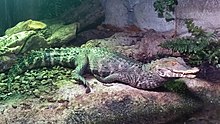
Cuvier's dwarf caiman (Paleosuchus palpebrosus) is a small crocodilian in the alligator family from northern and central South America. It is found in Bolivia, Brazil, Colombia, Ecuador, French Guiana, Guyana, Paraguay, Peru, Suriname, Trinidad and Venezuela. It lives in riverine forests, flooded forests near lakes, and near fast-flowing rivers and streams. It can traverse dry land to reach temporary pools and tolerates colder water than other species of caimans. Other common names for this species include the musky caiman, the dwarf caiman, Cuvier's caiman, and the smooth-fronted caiman (the latter name is also used for P. trigonatus). It is sometimes kept in captivity as a pet and may be referred to as the wedge-head caiman by the pet trade community.
Cuvier's dwarf caiman was first described by the French zoologist Georges Cuvier in 1807 and is one of only two species in the genus Paleosuchus, the other species being P. trigonatus. Their closest relatives are the other caimans in the subfamily Caimaninae. With a total length averaging 1.4 m (4.6 ft) for males and up to 1.2 m (3.9 ft) for females, Cuvier's dwarf caiman is not only the smallest extant species in the alligator and caiman family, but also the smallest of all crocodilians (unless the Congo dwarf crocodile is considered a valid species). An adult weighs around 5 to 7 kg (11 to 15 lb). Its lack of size is partly made up for by its strong body armor, provided by the bony bases to its dermal scales, which provides protection against predators. Juvenile dwarf caimans mainly feed on invertebrates, but also small fish and frogs, while adults eat larger fish, amphibians, and invertebrates, such as large molluscs. This caiman sometimes uses a burrow as shelter during the day and in the Pantanal may aestivate in the burrow to stay cool in the dry season. The female buries her eggs on a mounded nest and these take about 3 months to hatch. She helps the hatchlings to escape from the nest and provides some parental care for the first few weeks of their lives. This caiman has a wide range and large total population and the IUCN lists its conservation status as being of least concern. (Full article...) -
Image 5A smooth-fronted caiman at Zoologischer Garten Berlin in Berlin, Germany
The smooth-fronted caiman (Paleosuchus trigonatus), also known as Schneider's dwarf caiman or Schneider's smooth-fronted caiman, is a crocodilian from South America, where it is native to the Amazon and Orinoco Basins. It is the second-smallest species of the family Alligatoridae, the smallest being Cuvier's dwarf caiman, also from tropical South America and in the same genus. An adult typically grows to around 1.2 to 1.6 m (3.9 to 5.2 ft) in length and weighs between 9 and 20 kg (20 and 44 lb). Exceptionally large males can reach as much as 2.3 m (7.5 ft) in length and 36 kg (79 lb) in weight. (Full article...) -
Image 6An adult basking on the island of Palawan, Philippines
The Philippine crocodile (Crocodylus mindorensis), also known as the Mindoro crocodile, the Philippine freshwater crocodile, the bukarot in Ilocano, and more generally as a buwaya in most Filipino lowland cultures, is one of two species of crocodiles found in the Philippines; the other is the larger saltwater crocodile (Crocodylus porosus). The Philippine crocodile, the species endemic only to the country, went from data deficient to critically endangered in 2008 from exploitation and unsustainable fishing methods, such as dynamite fishing. Conservation methods are being taken by the Dutch/Filipino Mabuwaya foundation, the Crocodile Conservation Society and the Zoological Institute of HerpaWorld in Mindoro island. It is strictly prohibited to kill a crocodile in the country, and it is punishable by law. (Full article...) -
Image 7

The mugger crocodile (Crocodylus palustris) is a medium-sized broad-snouted crocodile, also known as mugger and marsh crocodile. It is native to freshwater habitats from southern Iran to the Indian subcontinent, where it inhabits marshes, lakes, rivers and artificial ponds. It rarely reaches a body length of 5 m (16 ft 5 in) and is a powerful swimmer, but also walks on land in search of suitable waterbodies during the hot season. Both young and adult mugger crocodiles dig burrows to which they retreat when the ambient temperature drops below 5 °C (41 °F) or exceeds 38 °C (100 °F). Females dig holes in the sand as nesting sites and lay up to 46 eggs during the dry season. The sex of hatchlings depends on temperature during incubation. Both parents protect the young for up to one year. They feed on insects, and adults prey on fish, reptiles, birds and mammals.
The mugger crocodile evolved at least 4.19 million years ago and has been a symbol for the fructifying and destructive powers of the rivers since the Vedic period. It was first scientifically described in 1831 and is protected by law in Iran, India and Sri Lanka. Since 1982, it has been listed as Vulnerable on the IUCN Red List. Outside protected areas, it is threatened by conversion of natural habitats, gets entangled in fishing nets and is killed in human–wildlife conflict situations and in traffic accidents. (Full article...) -
Image 8
The gharial (Gavialis gangeticus), also known as gavial or fish-eating crocodile, is a crocodilian in the family Gavialidae and among the longest of all living crocodilians. Mature females are 2.6 to 4.5 m (8 ft 6 in to 14 ft 9 in) long, and males 3 to 6 m (9 ft 10 in to 19 ft 8 in). Adult males have a distinct boss at the end of the snout, which resembles an earthenware pot known as a ghara, hence the name "gharial". The gharial is well adapted to catching fish because of its long, narrow snout and 110 sharp, interlocking teeth.
The gharial probably evolved in the northern Indian subcontinent. Fossil gharial remains were excavated in Pliocene deposits in the Sivalik Hills and the Narmada River valley. It currently inhabits rivers in the plains of the northern part of the Indian subcontinent. It is the most thoroughly aquatic crocodilian, and leaves the water only for basking and building nests on moist sandbanks. Adults mate at the end of the cold season. Females congregate in spring to dig nests, in which they lay 20–95 eggs. They guard the nests and the young, which hatch before the onset of the monsoon. The hatchlings stay and forage in shallow water during their first year, but move to sites with deeper water as they grow.
The wild gharial population has declined drastically since the 1930s and is limited to only 2% of its historical range today. Conservation programmes initiated in India and Nepal focused on reintroducing captive-bred gharials since the early 1980s. Loss of habitat because of sand mining and conversion to agriculture, depletion of fish resources and detrimental fishing methods continue to threaten the population. It has been listed as critically endangered on the IUCN Red List since 2007. (Full article...) -
Image 9
The dwarf crocodile (Osteolaemus tetraspis), also known as the African dwarf crocodile, broad-snouted crocodile (a name more often used for the Asian mugger crocodile) or bony crocodile, is an African crocodile that is also the smallest extant (living) species of crocodile. (Full article...) -
Image 10At Le Bonheur Crocodile Farm near Stellenbosch, South Africa
The Nile crocodile (Crocodylus niloticus) is a large crocodilian native to freshwater habitats in Africa, where it is present in 26 countries. It is widely distributed in sub-Saharan Africa, occurring mostly in the eastern, southern, and central regions of the continent, and lives in different types of aquatic environments such as lakes, rivers, swamps and marshlands. It occasionally inhabits deltas, brackish lakes and rarely also saltwater. Its range once stretched from the Nile Delta throughout the Nile River. Lake Turkana in Kenya has one of the largest undisturbed Nile crocodile populations.
Generally, the adult male Nile crocodile is between 3.5 and 5 m (11 ft 6 in and 16 ft 5 in) in length and weighs 225 to 750 kg (496 to 1,653 lb). However, specimens exceeding 6.1 m (20 ft) in length and 1,000 kg (2,200 lb) in weight have been recorded. It is the largest predator in Africa, and may be considered the second-largest extant reptile in the world, after the saltwater crocodile (Crocodylus porosus). Size is sexually dimorphic, with females usually about 30% smaller than males. The crocodile has thick, scaly, heavily armoured skin.
Nile crocodiles are opportunistic apex predators; a very aggressive crocodile, they are capable of taking almost any animal within their range. They are generalists, taking a variety of prey, with a diet consisting mostly of different species of fish, reptiles, birds, and mammals. As ambush predators, they can wait for hours, days, and even weeks for the suitable moment to attack. They are agile predators and wait for the opportunity for a prey item to come well within attack range. Even swift prey are not immune to attack. Like other crocodiles, Nile crocodiles have a powerful bite that is unique among all animals, and sharp, conical teeth that sink into flesh, allowing a grip that is almost impossible to loosen. They can apply high force for extended periods of time, a great advantage for holding down large prey underwater to drown. (Full article...) -
Image 11
The Orinoco crocodile (Crocodylus intermedius) is a critically endangered crocodile. Its population is very small, and they can only be found in the Orinoco river basin in Venezuela and Colombia. Extensively hunted for their skins in the 19th and 20th centuries, it is one of the most endangered species of crocodiles. It is a very large species of crocodilian; males have been reported up to 6.8 m (22 ft 4 in) in the past, weighing over 900 kg (2,000 lb), but such sizes do not exist today, 5.2 m (17 ft 1 in) being a more widely accepted maximum size. A large male today may attain 4.2 m (13 ft 9 in) in length and can weigh up to 450 kg (1,000 lb), while females are substantially smaller with the largest likely to weigh around 225 kg (496 lb). Sexual dimorphism is not as profound as in other crocodilian species. The coloration is light even in adults.
The ecology of the Orinoco crocodile is poorly documented in the wild, mostly due to its small population. It is thought to have a more piscivorous diet with an opportunistic nature, resulting in generalist predatory behaviour. It is an apex predator and preys on a variety of birds, mammals and reptiles, including caimans on occasion. Its prey base is mostly large predatory fish, challenging the general view by locals complaining about crocodiles hunting local fish to very low numbers. Reproduction takes place in the dry season when the water level is low. It is a hole nester and digs holes in the sand for its clutch of eggs. The females guard the nests and young for several years. (Full article...) -
Image 12
The saltwater crocodile (Crocodylus porosus) is a crocodilian native to saltwater habitats, brackish wetlands and freshwater rivers from India's east coast across Southeast Asia and the Sundaland to northern Australia and Micronesia. It has been listed as Least Concern on the IUCN Red List since 1996. It was hunted for its skin throughout its range up to the 1970s, and is threatened by illegal killing and habitat loss. It is regarded as dangerous to humans.
The saltwater crocodile is the largest living reptile. Males can grow up to a weight of 1,000–1,500 kg (2,200–3,300 lb) and a length of 6 m (20 ft), rarely exceeding 6.3 m (21 ft). Females are much smaller and rarely surpass 3 m (9.8 ft). It is also called the estuarine crocodile, Indo-Pacific crocodile, marine crocodile, sea crocodile, and, informally, the saltie. A large and opportunistic hypercarnivorous apex predator, they ambush most of their prey and then drown or swallow it whole. They will prey on almost any animal that enters their territory, including other predators such as sharks, varieties of freshwater and saltwater fish including pelagic species, invertebrates such as crustaceans, various amphibians, other reptiles, birds, and mammals. (Full article...) -
Image 13
The spectacled caiman (Caiman crocodilus), also known as the white caiman, common caiman, and speckled caiman, is a crocodilian in the family Alligatoridae. It is brownish-, greenish-, or yellowish-gray colored and has a spectacle-like ridge between its eyes, which is where its common name come from. It grows to a length of 1.4–2.5 m (4 ft 7 in – 8 ft 2 in) and a weight of 7–40 kg (15–88 lb), with males being both longer and heavier than females. Its diet varies seasonally, commonly consisting of crabs, fish, small mammals, amphibians and snails. Breeding occurs from May to August and 14–40 eggs are laid in July and August. This crocodilian has a large range and population; it is native to much of Latin America, and has been introduced to the United States, Cuba, and Puerto Rico. (Full article...) -
Image 14

The black caiman (Melanosuchus niger) is a crocodilian reptile endemic to South America. With a maximum length of around 5 to 6 m (16 to 20 ft) and a mass of over 450 kg (1,000 lb), it is the largest living species of the family Alligatoridae, and the third-largest crocodilian in the Neotropical realm. True to its common and scientific names, the black caiman has a dark greenish-black coloration as an adult. In some individuals, the pigmentation can appear almost jet-black. It has grey to brown banding on the lower jaw; juveniles have a more vibrant coloration compared to adults, with prominent white-pale yellow banding on the flanks that remains present well into adulthood (more than most other species). The banding on young animals helps with camouflage by breaking up their body outline, on land or in water, in an effort to avoid predation. The morphology is quite different from other caimans but the bony ridge that occurs in other caimans is present. The head is large and heavy, an advantage in catching larger prey. Like all crocodilians, caimans are long, squat creatures, with big jaws, long tails and short legs. They have thick, scaled skin, and their eyes and noses are located on the tops of their heads. This enables them to see and breathe while the rest of their bodies are underwater.
A carnivorous animal, the black caiman lives along freshwater habitats, including slow-moving rivers, lakes and seasonally flooded savannas, where it preys upon a variety of fish, reptiles, birds, and mammals. Being an apex predator and potentially a keystone species, it is generalist, capable of taking most animals within its range, and might have played a critical role in maintaining structure of the ecosystem. Although merely few specific ecological studies have been conducted, it is observed that this species has its own niche which allows coexistence with other competitors.
Reproduction takes place in the dry season. Females build a nest mound with an egg chamber, protecting the eggs from predators. Hatchlings form groups called pods, guarded by the presence of the female. These pods may contain individuals from other nests. Once common, it was hunted to near extinction primarily for its commercially valuable hide. It is now making a comeback, listed as Conservation Dependent. Overall a little-known species, it was not researched in any detail until the 1980s, when the leather-trade had already taken its toll. It is a dangerous species to humans, and attacks have occurred in the past. (Full article...) -
Image 15Mato Grosso, Brazil
The yacare caiman (Caiman yacare), also known commonly as the jacare caiman, Paraguayan caiman, piranha caiman, red caiman, and southern spectacled caiman, is a species of caiman, a crocodilian in the family Alligatoridae. The species is endemic to Argentina, Bolivia, Brazil, and Paraguay. Brown in color and covered with dark blotches, males grow to a total length (including tail) of 2–3 m (6 ft 7 in – 9 ft 10 in) and weigh around 40–50 kg (88–110 lb); while females grow to 1.4 m (4 ft 7 in) long and about 15–20 kg (33–44 lb). Typical habitats of this caiman include lakes, rivers, and wetlands. Its diet primarily consists of aquatic animals, such as snails, and occasionally land vertebrates. Mating occurs in the rainy season and eggs hatch in March, with young fending for themselves as soon as they hatch. The yacare caiman was hunted heavily for its skin to use for leather in the 1980s, which caused its population to decrease significantly. However, trading restrictions placed since have caused its population to increase. Its population in the Pantanal is about 10 million, and it is listed as least concern on the IUCN Red List. (Full article...) -
Image 16
Mecistops is a genus of crocodiles, the slender-snouted crocodiles, native to sub-Saharan Africa. (Full article...) -
Image 17At Zapata Swamp, Matanzas Province, Cuba
The Cuban crocodile (Crocodylus rhombifer) is a small-medium species of crocodile endemic to Cuba. Typical length is 2.1–2.3 m (6.9–7.5 ft) and typical weight 70–80 kg (150–180 lb). Large males can reach as much as 3.5 m (11 ft) in length and weigh more than 215 kg (474 lb). Despite its smaller size, it is a highly aggressive animal (one of the most territorial of all crocodilians), and potentially dangerous to humans.
The Cuban crocodile is of interest to biologists for its unique physical and behavioral traits. Long- and strong-legged, it is the most terrestrial of extant crocodiles. Its preferred habitat comprises freshwater and brackish water environments, such as mangrove swamps, coastal lagoons, estuaries, marshes, floodplains, and river deltas. There, the adults feed on fish, turtles and small mammals, while the young eat invertebrates and smaller fish. Mating occurs between May and July. Captive animals have displayed cooperative hunting behavior, and can be taught tricks, suggesting intelligence.
The Cuban crocodile is listed as Critically Endangered by the International Union for Conservation of Nature. Once spread across the Caribbean, its range has dwindled to including only the Zapata Swamp and Isla de la Juventud, due to hunting by humans. Captive breeding projects are in place to help the species recover.
The species fossil record reveals it had at one point a greater range, with fossil remains being found in The Bahamas, Hispaniola (in the Dominican Republic), and the Cayman Islands. (Full article...) -
Image 18
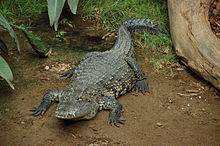
Morelet's crocodile (Crocodylus moreletii), also known as the Mexican crocodile or Belize crocodile, is a modest-sized crocodilian found only in the Atlantic regions of Mexico, Belize and Guatemala. It usually grows to about 3 metres (10 ft) in length. It is a species at least concern for extinction according to the International Union for Conservation of Nature.
The species has a fossil record in Guatemala. (Full article...) -
Image 19At La Manzanilla, Jalisco, Mexico
The American crocodile (Crocodylus acutus) is a species of crocodilian found in the Neotropics. It is the most widespread of the four extant species of crocodiles from the Americas, with populations present from South Florida, the Caribbean islands of Cuba, Jamaica, Hispaniola, and the coasts of Mexico to as far south as Peru, Ecuador, Colombia, and Venezuela.
The habitat of the American crocodile consists largely of coastal areas. It is also found in river systems, but tends to prefer salinity, resulting in the species congregating in brackish lakes, mangrove swamps, lagoons, cays, and small islands. Other crocodiles also have tolerance to saltwater due to salt glands underneath the tongue, but the American crocodile is the only species other than the saltwater crocodile to commonly live and thrive in saltwater. They can be found on beaches and small island formations without any freshwater source, such as many cays and islets across the Caribbean. They are also found in hypersaline lakes; one of the largest known populations inhabits Lago Enriquillo in the Dominican Republic.
The American crocodile is one of the largest crocodile species. Males can reach lengths of more than 6.1 m (20 ft 0 in), weighing over 1,000 kilograms (2,200 lb). On average, mature males are more in the range of 2.9 to 4.1 m (9 ft 6 in to 13 ft 5 in) in length weighing up to about 400 kg (880 lb). As with other crocodile species, females are smaller, rarely exceeding 3.8 m (12 ft 6 in) in length even in the largest-bodied population. (Full article...) -
Image 20
The Siamese crocodile (Crocodylus siamensis) is a medium-sized freshwater crocodile native to Indonesia (Borneo and possibly Java), Brunei, East Malaysia, Laos, Cambodia, Myanmar, Thailand and Vietnam. The species is critically endangered and already extirpated from many regions. Its other common names include Siamese freshwater crocodile, Singapore small-grain, and soft-belly. (Full article...) -
Image 21Specimen in Bazoulé, Burkina Faso
The West African crocodile, desert crocodile, or sacred crocodile (Crocodylus suchus) is a species of crocodile related to, and often confused with, the larger and more aggressive Nile crocodile (C. niloticus). (Full article...) -
Image 22At the Columbus Zoo and Aquarium in Powell, Ohio
The American alligator (Alligator mississippiensis), sometimes referred to as a gator, or common alligator is a large crocodilian reptile native to the Southeastern United States and a small section of northeastern Mexico. It is one of the two extant species in the genus Alligator, and is larger than the only other living alligator species, the Chinese alligator.
Adult male American alligators measure 3.4 to 4.6 m (11.2 to 15.1 ft) in length, and can weigh up to 500 kg (1,100 lb), with unverified sizes of up to 5.84 m (19.2 ft) and weights of 1,000 kg (2,200 lb) making it the second largest member by length and the heaviest of the family Alligatoridae, after the black caiman. Females are smaller, measuring 2.6 to 3 m (8.5 to 9.8 ft) in length. The American alligator inhabits subtropical and tropical freshwater wetlands, such as marshes and cypress swamps, from southern Texas to North Carolina. It is distinguished from the sympatric American crocodile by its broader snout, with overlapping jaws and darker coloration, and is less tolerant of saltwater but more tolerant of cooler climates than the American crocodile, which is found only in tropical and warm subtropical climates.
American alligators are apex predators and consume fish, amphibians, reptiles, birds, and mammals. Hatchlings feed mostly on invertebrates. They play an important role as ecosystem engineers in wetland ecosystems through the creation of alligator holes, which provide both wet and dry habitats for other organisms. Throughout the year (in particular during the breeding season), American alligators bellow to declare territory, and locate suitable mates. Male American alligators use infrasound to attract females. Eggs are laid in a nest of vegetation, sticks, leaves, and mud in a sheltered spot in or near the water. Young are born with yellow bands around their bodies and are protected by their mother for up to one year. This species displays parental care, which is rare for most reptiles. Mothers protect their eggs during the incubation period, and moves the hatchlings to the water using her mouth. (Full article...) -
Image 23
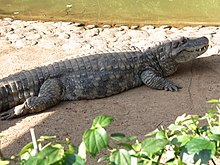
The broad-snouted caiman (Caiman latirostris) is a crocodilian in the family Alligatoridae found in eastern and central South America, including the Pantanal habitat of Bolivia, Southeast Brazil, and Paraguay, as well as northern Argentina and Uruguay. Behind the black caiman (Melanosuchus niger), it is the second-largest caiman species; it is the third-largest alligatorid behind the American alligator (Alligator mississippiensis) and the aforementioned black caiman. Primarily, the species inhabits freshwater wetlands, including floodplains, marshes, swamps, and some mangrove forests, as well as various streams, rivers, lakes or ponds, preferring bodies of rather still or slower-moving water. They will often utilize man-made cow ponds, disused stock tanks, and canals and ditches, as well. (Full article...)
Selected lizard articles
-
Image 1

The Galápagos land iguana (Conolophus subcristatus) is a very large species of lizard in the family Iguanidae, and one of three species of the genus Conolophus. It is endemic to the Galápagos Islands off of Ecuador's Pacific coast, inhabiting the dry lowlands of Fernandina, Isabela, Santa Cruz, North Seymour, Baltra, and South Plaza islands. (Full article...) -
Image 2

Chondrodactylus bibronii, commonly known as Bibron's thick-toed gecko, Bibron's sand gecko, or simply Bibron's gecko, is a species of lizard in the family Gekkonidae. The species is native to southern Africa. C. bibronii has been used as an animal model in bioastronautic research examining the effects of spaceflight on the morphology and physiology of vertebrates. (Full article...) -
Image 3

The Knysna dwarf chameleon (Bradypodion damaranum) is a species of dwarf chameleon in the Bradypodion ("slow footed") genus that is endemic to South Africa. It is a forest dweller, found only in a limited range in the afromontane forests near Knysna, South Africa, and in certain surrounding areas. (Full article...) -
Image 4
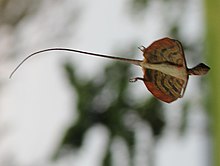
Draco taeniopterus, the Thai flying dragon, barred flying dragon, or barred gliding lizard, is a species of agamid lizard. It is found in Myanmar, Thailand, Cambodia, and Malaysia. (Full article...) -
Image 5

Draco melanopogon, commonly known as the black-bearded gliding lizard or black-barbed flying dragon, is a species of agamid "flying lizard" endemic to Southeast Asia. It is a typically forest-dwelling arboreal lizard. It preys on small invertebrates like ants and is oviparous. They are notable for relying solely on dewlap-mediated communication, instead of conveying signals via both headbobbing and employing dewlaps, as is typical for lizards with dewlaps. (Full article...) -
Image 6

The Robertson dwarf chameleon, also known as the Little Karoo dwarf chameleon, (Bradypodion gutturale) is a chameleon in the genus Bradypodion. It is found in the dry Fynbos and Renosterveld shrub vegetation, in the centre of the Western Cape province, South Africa. (Full article...) -
Image 7
Draco volans, also commonly known as the common flying dragon, is a species of lizard in the family Agamidae. The species is endemic to Southeast Asia. Like other members of genus Draco, this species has the ability to glide using winglike lateral extensions of skin called patagia.
The species is exclusively arboreal. (Full article...) -
Image 8
Varanus spinulosus, the Solomon Island spiny monitor, Isabel monitor, or spiny-neck monitor, is a species of monitor lizard. It is endemic to the Solomon Islands archipelago and is also known from Santa Isabel Island, San Jorge Island (Solomon Islands) and Bourgainville Island (Papua New Guinea). (Full article...) -
Image 9
The Asian water monitor (Varanus salvator) is a large varanid lizard native to South and Southeast Asia. It is widely considered to be the second-largest lizard species, after the Komodo dragon. It is distributed from eastern and northeastern India and Bangladesh, the Andaman and Nicobar Islands, Sri Lanka, through southern China and Hainan Island in the east to mainland Southeast Asia and the islands of Sumatra, Borneo, Java, Lombok, the Riau Archipelago, Sulawesi. It is one of the most widespread monitor lizards.
The Asian water monitor has a natural affinity towards water, inhabiting the surroundings of lakes, rivers, ponds, swamps and various riparian habitats, including sewers, city parks, and urban waterways. It is an excellent swimmer and hunts fish, frogs, invertebrates, water birds, and other types of aquatic and amphibious prey.
Due to its apparently large, stable population, it is currently listed as Least Concern on to the IUCN Red List. (Full article...) -
Image 10
The common house gecko (Hemidactylus frenatus) is a gecko native to South and Southeast Asia as well as Near Oceania. It is also known as the Asian house gecko, Pacific house gecko, wall gecko, house lizard, tiktiki, chipkali or moon lizard.
These geckos are nocturnal; hiding during the day and foraging for insects at night. They can be seen climbing walls of houses and other buildings in search of insects attracted to porch lights, and are immediately recognisable by their characteristic chirping.
They grow to a length of between 7.5–15 cm (3–6 in), and live for about 7 years. These small geckos are non-venomous and not harmful to humans. Most medium-sized to large geckos are docile, but may bite if distressed, which might pierce skin. The common house gecko is a tropical species, and thrives in warm, humid areas where it can crawl around on rotting wood in search of the insects it eats, as well as within urban landscapes in warm climates. The animal is very adaptable and may prey on insects and spiders, displacing other gecko species which are less robust or behaviourally aggressive. In parts of Australia and Papua New Guinea they are often confused with a similar native lizard, the dubious dtella. (Full article...) -
Image 11

The Mediterranean house gecko (Hemidactylus turcicus) is a species of house gecko native to the Mediterranean region, from which it has spread to many parts of the world including parts of East Africa, South America, the Caribbean, and the Southern and Southeastern United States. It is commonly referred to as the Turkish gecko as represented in its Latin name and also as the moon lizard because it tends to emerge in the evening.
A study in Portugal found H. turcicus to be totally nocturnal, with its highest activity around 02:00. It is insectivorous, rarely exceeds 15 cm (5.9 in) in length, has large, lidless eyes with elliptical pupils, and purple or tan-colored skin with black spots, often with stripes on the tail. Its belly or undersides are somewhat translucent. What impact this gecko has on native wildlife in the regions to which it has been introduced is unknown.
In many parts of the world, the range of H. turcicus is increasing, and unlike many other reptiles, it appears to be highly resistant to pesticides. The increase may be explained as a consequence of having few predators in places where it has been introduced, and also of its tendency to take shelter in the cracks and unseen areas of human homes, for example inside walls. Reliance on human habitation has thus contributed to the species' proliferation, similar to rodents. In some Eastern Mediterranean countries such as Turkey and Cyprus, harming H. turcicus is taboo due to its benign nature, and it is often kept as a house pet. (Full article...) -
Image 12

Draco timoriensis, also known as the Timor flying dragon, is a species of lizard endemic to the Lesser Sunda Islands in Indonesia and East Timor. (Full article...) -
Image 13

The clouded monitor (Varanus nebulosus) is a species of monitor lizard, native to Myanmar, Thailand and Indochina to West Malaysia, Singapore, Java, Sumatra, and Vietnam. They are excellent tree climbers. It belongs to the subgenus Empagusia along with the Bengal monitor, the Dumeril's monitor and other monitor lizards. It had previously been listed as a subspecies of Bengal monitor by some herpetologists. It is a diurnal monitor. (Full article...) -
Image 14
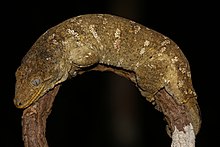
Rhacodactylus leachianus, commonly known as the New Caledonian giant gecko, Leach's giant gecko, leachianus gecko, or Leachie, is the largest living species of gecko and a member of the family Diplodactylidae. It is native to most of New Caledonia. (Full article...) -
Image 15
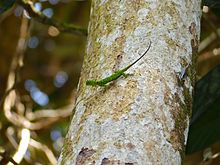
Draco cornutus is a species of "flying dragon", an agamid lizard. It is endemic to Borneo. It occurs at elevations up to 700 m (2,300 ft) above sea level, although its distribution is poorly known. (Full article...) -
Image 16
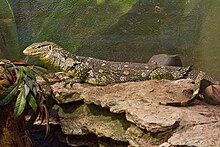
The ornate monitor (Varanus niloticus ornatus) is a monitor lizard that is native to West and Middle Africa. Comprehensive molecular analyses of the group have demonstrated that animals previously assigned to "Varanus ornatus" do not constitute a valid taxon and are actually polymorphisms of two different species; Varanus stellatus (west African Nile monitor) and Varanus niloticus (Nile monitor). Consequently, Varanus ornatus is considered a synonym of Varanus niloticus and "ornate monitor" is an informal term for forest forms of either species (V. niloticus or V. stellatus).
Until 1997, the ornate monitor was considered a subspecies of the Nile monitor. It was subsequently described as a separate species on the basis of reduced number of ocelli rows on the body, a light coloured tongue and a more massive build. More recent work based on a large sample size using mitochondrial and nuclear DNA sequences indicates that Varanus ornatus is not a valid species and that animals with the diagnostic appearance belong either of two sister species of Nile monitor. Animals described as ornate monitor lizards are native to closed canopy forests in West and Middle Africa. (Full article...) -
Image 17An adult green iguana in Costa Rica
The green iguana (Iguana iguana), also known as the American iguana or the common green iguana, is a large, arboreal, mostly herbivorous species of lizard of the genus Iguana. Usually, this animal is simply called the iguana. The green iguana ranges over a large geographic area; it is native from southern Brazil and Paraguay as far north as Mexico.
A herbivore, it has adapted significantly with regard to locomotion and osmoregulation as a result of its diet. It grows to 1.7 m (5.6 ft) in length from head to tail, although a few specimens have grown more than 2 m (6.6 ft) with bodyweights upward of 9 kg (20 lb).
Commonly found in captivity as a pet due to its calm disposition and bright colors, it can be very demanding to care for properly. Space requirements and the need for special lighting and heat can prove challenging to the hobbyist. (Full article...) -
Image 18

The Indo-Pacific gecko (Hemidactylus garnotii), also known commonly as Garnot's house gecko, fox gecko, and the Assam greyish brown gecko, is a species of lizard in the family Gekkonidae. The species is found in India, across Southeast Asia, Australia, and throughout Polynesia. Adults are about 4 to 5 in (10 to 13 cm) in total length (including tail). They are seen as dark gray or brown with light markings in daylight and a pale, translucent colour at night. The belly is orange or yellow. The head has a long, narrow snout, hence the name fox gecko. The flattened tail has a row of spiny scales on the lateral edges. The species is parthenogenic – all individuals are female and lay eggs that hatch without requiring male fertilisation.
In Hawaii, the species is thought to be a long-term resident. Formerly considered a house gecko, it has been displaced to natural habitats by the more recently arrived common house gecko. In Florida and Georgia, it has become established as an invasive species of concern. (Full article...) -
Image 19
The Cape dwarf chameleon (Bradypodion pumilum) is a chameleon native to the South African province of the Western Cape, where it is restricted to the region around Cape Town.
As with most chameleons, its tongue is twice the length of its body and it can be shot out of its mouth using a special muscle in the jaw. This gives the chameleon the ability to catch insects some distance away. (Full article...) -
Image 20

The Northern Sierra Madre forest monitor (Varanus bitatawa), also known by the local names bitatawa, baritatawa, and butikaw, is a large, arboreal, frugivorous lizard of the genus Varanus. (Full article...) -
Image 21
The Komodo dragon (Varanus komodoensis), also known as the Komodo monitor, is a large reptile of the monitor lizard family Varanidae that is endemic to the Indonesian islands of Komodo, Rinca, Flores, Gili Dasami, and Gili Motang. It is the largest extant species of lizard, with the males growing to a maximum length of 3 m (10 ft) and weighing up to 150 kg (330 lb).
As a result of their size, Komodo dragons are apex predators, and dominate the ecosystems in which they live. Komodo dragons hunt and ambush prey including invertebrates, birds, and mammals. Komodo dragons' group behavior in hunting is exceptional in the reptile world. The diet of Komodo dragons mainly consists of Javan rusa (Rusa timorensis), though they also eat considerable amounts of carrion. Komodo dragons also occasionally attack humans.
Mating begins between May and August, and the eggs are laid in September; as many as 20 eggs are deposited at a time in an abandoned megapode nest or in a self-dug nesting hole. The eggs are incubated for seven to eight months, hatching in April, when insects are most plentiful. Young Komodo dragons are vulnerable and dwell in trees to avoid predators, such as cannibalistic adults, which young Komodo dragons also try to repel by rolling in feces. They take 8 to 9 years to mature and are estimated to live up to 30 years. (Full article...) -
Image 22
The Transkei dwarf chameleon or Pondo dwarf chameleon (Bradypodion caffer) is a chameleon endemic to the Eastern Cape Province of South Africa. (Full article...) -
Image 23

Lepidodactylus lugubris, known as the mourning gecko or common smooth-scaled gecko, is a species of lizard, a gecko of the family Gekkonidae. (Full article...) -
Image 24
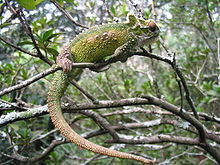
The Natal Midlands dwarf chameleon (Bradypodion thamnobates) is a chameleon native to woodland habitat in the inland Midlands area of the South African province of KwaZulu-Natal. (Full article...) -
Image 25Draco guentheri, commonly known as Günther's flying lizard is a species of "flying dragon" in the family Agamidae. The species is endemic to the Philippines. (Full article...)
Selected turtle articles
-
Image 1Philippen's striped turtle, "Mauremys" philippeni, has recently shown to be an intergeneric hybrid (Stuart & Parham, 2006) between a male Mauremys sinensis and a female Cuora trifasciata.
The "species" is known only from a handful of specimens (mainly the type series), said to originate from Hainan, but all acquired from a pet trader in Hong Kong. (Full article...) -
Image 2
The Chinese box turtle (simplified Chinese: 食蛇龟; traditional Chinese: 食蛇龜; pinyin: shíshéguī; lit. 'Snake-eating turtle'), also known as the yellow-margined box turtle, or golden-headed turtle, is a species of Asian box turtle. Taxonomically, it is called Cuora flavomarginata. (Full article...) -
Image 3

The Maracaibo wood turtle (Rhinoclemmys diademata) is a species of turtles in the family Geoemydidae. The species is endemic to northern South America. (Full article...) -
Image 4

The twist-necked turtle (Platemys platycephala), also known as the flat-headed turtle, is distributed widely across northern South America. Twist-necked turtles have extremely flat shells that help them hide from predators under rocks and debris. When threatened, this turtle withdraws by twisting its head into its shell. P. platycephala is the only species of the genus Platemys and occurs in northern and central South America. Platemys platycephala means "flat turtle, flat-head" and accurately describes the structure of the head and shell. This species inhabits shallow creek beds and frequently forages on the floor of the Amazon rainforest for insects, amphibians, and mollusks. Camouflage, head and body shape, and advanced sexual anatomy allow this species of turtle to effectively populate much of South America. Mating occurs during rainy months (March–December) and egg deposit occurs during dry months (January–March). Males have been known to behave aggressively towards females during copulation by squirting water from nostrils and biting. A few genomic studies show mosaicism exists among populations of the twist-necked turtle in Suriname. In other words, diploid and triploid levels exist among individuals at this particular location. No threats have been reported for this species and the International Union for Conservation of Nature does not have a current listing. Lack of human consumption due to the species' small size and its wide range explain why scientists are not concerned about this turtle species. (Full article...) -
Image 5

The Assam roofed turtle or Sylhet roofed turtle (Pangshura sylhetensis) is a turtle species of the family Geoemydidae found in the Brahmaputra-Meghna drainage in India (Assam) and parts of eastern Bangladesh. It was formerly placed in the genus Batagur and the defunct genus Kachuga. (Full article...) -
Image 6A green sea turtle, a species of the sea turtle superfamily
Sea turtles (superfamily Chelonioidea), sometimes called marine turtles, are reptiles of the order Testudines and of the suborder Cryptodira. The seven existing species of sea turtles are the flatback, green, hawksbill, leatherback, loggerhead, Kemp's ridley, and olive ridley.
Six of the seven sea turtle species, all but the flatback, are present in U.S. waters, and are listed as endangered and/or threatened under the Endangered Species Act. All but the flatback turtle are listed as threatened with extinction globally on the IUCN Red List of Threatened Species. The flatback turtle is found only in the waters of Australia, Papua New Guinea, and Indonesia.
Sea turtles can be categorized as hard-shelled (cheloniid) or leathery-shelled (dermochelyid). The only dermochelyid species of sea turtle is the leatherback. (Full article...) -
Image 7The Upemba mud turtle (Pelusios upembae) is a species of turtle in the family Pelomedusidae.
It is endemic to Democratic Republic of the Congo. (Full article...) -
Image 8A common snapping turtle crossing the trail at John Heinz NWR
The common snapping turtle (Chelydra serpentina) is a species of large freshwater turtle in the family Chelydridae. Its natural range extends from southeastern Canada, southwest to the edge of the Rocky Mountains, as far east as Nova Scotia and Florida. The present-day Chelydra serpentina population in the Middle Rio Grande suggests that the common snapping turtle has been present in this drainage since at least the seventeenth century and is likely native. The three species of Chelydra and the larger alligator snapping turtles (genus Macrochelys) are the only extant chelydrids, a family now restricted to the Americas. The common snapping turtle, as its name implies, is the most widespread.
The common snapping turtle is noted for its combative disposition when out of the water with its powerful beak-like jaws, and highly mobile head and neck (hence the specific epithet serpentina, meaning "snake-like"). In water, it is likely to flee and hide underwater in sediment. The common snapping turtle has a life-history strategy characterized by high and variable mortality of embryos and hatchlings, delayed sexual maturity, extended adult longevity, and iteroparity (repeated reproductive events) with low reproductive success per reproductive event.
Females, and presumably also males, in more northern populations mature later (at 15–20 years) and at a larger size than in more southern populations (about 12 years). Lifespan in the wild is poorly known, but long-term mark-recapture data from Algonquin Park in Ontario, Canada, suggest a maximum age over 100 years. (Full article...) -
Image 9Female M. l. saharica in Morocco
The Iberian pond turtle (Mauremys leprosa), also known as the Mediterranean pond turtle or Mediterranean turtle, is a species of turtle in the family Geoemydidae. The species is endemic to southwestern Europe and northwestern Africa. (Full article...) -
Image 10In Siam Center, Thailand
The pig-nosed turtle (Carettochelys insculpta), also known as the Fly River turtle, the pitted-shelled turtle, and the Warrajan is a species of turtle which is native to northern Australia and southern New Guinea. It is the only living member of the genus Carettochelys and family Carettochelyidae, a family which also contains many fossil species with their closest relatives being the softshell turtles (family Trionychidae). (Full article...) -
Image 11

The Nubian flapshell turtle or Nubian soft-shelled turtle (Cyclanorbis elegans) is one of two species of softshell turtle in the genus Cyclanorbis of the Trionychidae family. It is thought to have ranged from West Africa east through Central Africa to South Sudan, although it has been extirpated from the vast majority of its range. (Full article...) -
Image 12
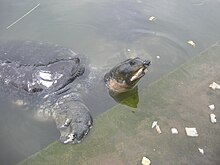
The black softshell turtle or Bostami turtle (Nilssonia nigricans), previously placed in genus Aspideretes, is a species of freshwater turtle found in India (Assam and Tripura) and Bangladesh (Chittagong and Sylhet). It was long believed to consist of inbred individuals of the Indian softshell turtle (A. gangeticus or N. gangeticus) or the Indian peacock softshell turtle (A. hurum or N. hurum), but while it is a close relative of the latter, it is a distinct species.
In the 1800s, it was believed these turtles were brought from Iran to Chittagong shrine pond by Hazrat Bayezid Bostami. His turtles he had brought to this pond were treated as sacred and respected by the public. Previously declared extinct by the International Union for Conservation of Nature in 2002, these turtles were found still to exist in a temple's pond called the Hayagriva Madhava Temple located in Assam, and in Kalyan Sagar lake in Tripura Sundari Temple in Udaipur, Tripura, India. Through conservation methods and protection of the species, some of these turtles can be found today throughout the wild, and scientists and environmental biologists are continuing to work hard to preserve this endangered species and their natural habitat. Their mitogenome represents relatedness to 19 other species of the Testudines. Nilssonia nigricans is the sister species of Nilssonia formosa. (Full article...) -
Image 13
The Plymouth red-bellied turtle, sometimes called the Plymouth red-bellied cooter, is a disjunct population of northern red-bellied cooter (Pseudemys rubriventris) endemic to Massachusetts. (Full article...) -
Image 14
The Roti Island snake-necked turtle (Chelodina mccordi), also commonly known as McCord's snakeneck turtle, is a critically endangered turtle species. It is named after Rote Island in Indonesia where it was first discovered. Some individuals were later discovered in East Timor, and are considered a distinct subspecies. (Full article...) -
Image 15

The eastern long-necked turtle (Chelodina longicollis) is an east Australian species of snake-necked turtle that inhabits a wide variety of water bodies and is an opportunistic feeder. It is a side-necked turtle (Pleurodira), meaning that it bends its head sideways into its shell rather than pulling it directly back. (Full article...) -
Image 16
The Florida box turtle (Terrapene carolina bauri) is a subspecies of turtle belonging to the family Emydidae and is one of six extant subspecies of the common box turtle (T. carolina) (Full article...) -
Image 17

The Gulf Coast box turtle (Terrapene carolina major) is the largest subspecies of the common box turtle (Terrapene carolina). (Full article...) -
Image 18
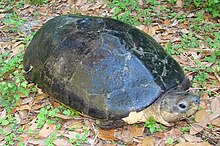
The Malaysian giant turtle or Bornean river turtle (Orlitia borneensis) is a species of turtle in the family Bataguridae. It is monotypic within the genus Orlitia. It is found in Indonesia and Malaysia.
This species is the largest freshwater turtle in Southeast Asia, reaching a maximum length of 80 cm (31 inches) and a maximum weight of up to 50 kg (110 pounds). It inhabits large lakes, swamps, and slow-flowing rivers. This mainly piscivorous (fish-eating) species has a dark brown or black carapace which is smooth and oval in shape and a pale yellowish-brown to off-white plastron. The head is powerful, with strong jaws and a slightly projecting snout, and the heads of adults are uniformly colored dark brown to black whereas juveniles are dark mottled with a pale line extending from the mouth to the back of the head. It occasionally takes fallen fruit and may consume and other available vertebrate. This species is exported in huge amounts from Indonesia for its highly prized flesh and despite its rarity it is not protected in Malaysia. Habitat destruction for palm oil plantations and poaching for the Chinese medicinal trade have also contributed to its Critically Endangered IUCN status. (Full article...) -
Image 19
The Asian narrow-headed softshell turtle (Chitra chitra) is a large species of softshell turtle in the family Trionychidae. The species is endemic to Southeast Asia. (Full article...) -
Image 20
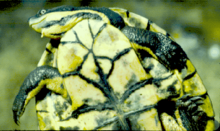
The Manning River snapping turtle (Myuchelys purvisi), or Manning River saw-shelled turtle, is a species of turtle in the family Chelidae, endemic to Australia. (Full article...) -
Image 21

The yellow-headed box turtle or golden-headed box turtle (Cuora aurocapitata) is a proposed species of turtle in the family Geoemydidae (formerly Bataguridae). It is sometimes considered a subspecies of Pan's box turtle (Cuora pani aurocapitata).
This turtle is endemic to the central Chinese Anhui province. It is found in Nanling County, Yi County, Guangde County, and Jing County. (Full article...) -
Image 22Pond turtle may refer to:
- Emydidae, a family of pond turtles
- Emys, a genus of Emydidae
- European pond turtle (Emys orbicularis)
- Sicilian pond turtle (Emys trinacris)
- Western pond turtle (Actinemys marmorata or Emys marmorata)
- Emys, a genus of Emydidae
- Giant Asian pond turtle (Heosemys grandis)
- Mauremys, a genus of pond turtles
- Chinese pond turtle (Mauremys reevesii)
- Japanese pond turtle (Mauremys japonica)
- Philippine forest turtle or Leyte pond turtle (Heosemys leytensis)
- Emydidae, a family of pond turtles
-
Image 23

Parker's snake-necked turtle (Chelodina parkeri) is a species of turtle in the family Chelidae. (Full article...) -
Image 24

The golden coin turtle (Cuora trifasciata), also known commonly as the Chinese three-banded box turtle and the Chinese three-striped box turtle, is a species of turtle in the family Geoemydidae. The species is native to southern China. There are two recognized subspecies. (Full article...) -
Image 25

The black spine-neck swamp turtle (Acanthochelys spixii), also commonly known as the spiny-neck turtle or Spix's sideneck turtle, is a species of turtle in the family Chelidae. The species is endemic to South America, specially in the Southern Cone region. (Full article...)
Selected pictures
-
Image 1A baby marginated tortoise hatchling emerges from its shell.
-
Image 2Gold dust day gecko close-up
-
Image 3Green sea turtle
-
Image 5Mexican beaded lizard
-
Image 6Steneosaurus
-
Image 7Trachylepis maculilabris mating
-
Image 8Sinai agama
-
Image 9Yacare caiman
-
Image 10Common box turtle
-
Image 11Niveoscincus metallicus
-
Image 12Leiocephalus personatus
-
Image 13The plumed basilisk (Basiliscus plumifrons) is a species of lizard native to Latin America. They are omnivorous and will eat insects, small mammals (such as rodents), smaller species of lizards, fruits and flowers.
-
Image 14Green sea turtle
-
Image 15Anole at Polychrotinae
-
Image 16Gold dust day gecko
-
Image 17Dwarf yellow-headed gecko
-
Image 18Indian chameleon
-
Image 19Common collared lizard
-
Image 20Thamnophis elegans terrestris at Western terrestrial garter snake
-
Image 21Aldabra giant tortoise
-
Image 22A green sea turtle swimming above a coral reef.
-
Image 23Cape skink - Trachylepis capensis. Close-up on purple Aster flowers.
-
Image 24Eastern bearded dragon
-
Image 25Green sea turtle (Chelonia mydas), Hawaiian Islands. Ninety percent of the Hawaiian green turtle population, known locally as honu, breed and nest at French Frigate Shoals, from April to November. Males apparently make the journey every year, while females make it at two to four year intervals. They are the subject of eco-tourism and has become something of a state mascot.
-
Image 26Marine iguana
-
Image 27Italian wall lizard
-
Image 28Leiocephalus carinatus
-
Image 29Cerastes cerastes
-
Image 30Ladder snake
-
Image 31Vipera xanthina
-
Image 32Mwanza flat-headed rock agama
-
Image 33Morelia spilota
-
Image 34Trachylepis striata
-
Image 36Australian water dragon
-
Image 37An Eastern long-necked turtle (Chelodina longicollis) covered in algae, in Victoria, Australia.
-
Image 38Gold dust day gecko
-
Image 39Bosc's fringe-toed lizards during courtship
-
Image 40Sicilian wall lizard
-
Image 41Asian vine snake Ahaetulla prasina. This snake has a wide distribution in Asia. It feeds on small reptiles and amphibians, particularly lizards and tree frogs. Adults may attain 1.8 m (6 feet) in total length, with a tail 0.6 m (2 feet) long. Its appearance is very much like those of South American vine snakes. It is a rear-fanged species and is mildly venomous but is not considered a threat to humans.
-
Image 42Phelsuma grandis
-
Image 43Species of Ceratopsia dinosaurs
-
Image 44Namaqua chameleon
-
Image 45Bothriechis schlegelii
-
Image 46Jackson's chameleon
-
Image 47Plestiodon fasciatus
-
Image 48Carolina anole
-
Image 49Namaqua chameleon
-
Image 50Barracudasauroides
-
Image 51Vipera dinniki
-
Image 52Rough chameleon
-
Image 53White-headed dwarf gecko
Selected snake articles
-
Image 1Indian egg-eater at Amravati
The Indian egg-eating snake or Indian egg-eater (Elachistodon westermanni) is a rare species of egg-eating snake in the family Colubridae. The species is endemic to the Indian subcontinent. It is also called Westermann's snake, reflecting its scientific name. The snake belongs to the monotypic genus Elachistodon. (Full article...) -
Image 2

Protobothrops elegans is a pit viper species endemic to Japan in the southern Ryukyu Islands. No subspecies are currently recognized. Common names include: elegant pit viper, Sakishima habu (サキシマハブ), and elegant tree viper. (Full article...) -
Image 3
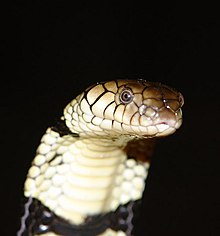
Naja annulata (formerly Boulengerina annulata), commonly known as the banded water cobra or the ringed water cobra, is a species of water cobra native to western and central Africa.
The species is one of the two species of water cobra in the world, the other one being the Congo water cobra (Naja christyi). (Full article...) -
Image 4
Mixcoatlus melanurus is a pit viper species endemic to the mountains of southern Mexico. No subspecies are currently recognized. (Full article...) -
Image 5
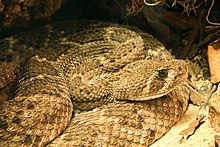
The western diamondback rattlesnake or Texas diamond-back (Crotalus atrox) is a rattlesnake species and member of the viper family, found in the southwestern United States and Mexico. Like all other rattlesnakes and all other vipers, it is venomous. It is likely responsible for the majority of snakebite fatalities in northern Mexico and the greatest number of snakebites in the U.S. No subspecies are currently recognized.
It lives in elevations from below sea level up to 6,500 feet (2,000 m). This species ranges throughout the Southwestern United States and northern half of Mexico. Currently, western diamondback rattlesnakes are not threatened or endangered. (Full article...) -
Image 6

Trimeresurus purpureomaculatus is a venomous pit viper species native to India, Bangladesh and Southeast Asia. Common names include: mangrove pit viper, mangrove viper, and shore pit viper. (Full article...) -
Image 7
-
Image 8
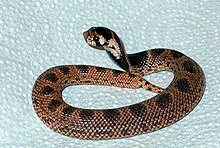
The shield-nosed cobra (Aspidelaps scutatus), or eastern shield-nose snake, is a venomous snake of the family Elapidae.
The shield-nosed cobra is mainly found in Botswana, Eswatini, Lesotho, Malawi, Mozambique, Namibia, South Africa, Zambia and Zimbabwe. They can survive between 20 and 28 years in captivity, though this age is normally not attained in the wild due to predation, accidents, etc. This species of snake is highly venomous, and has been attributed to at least one reported death of a human, despite its propensity to bite being somewhat low. The venom is highly neurotoxic, and no known antivenin is currently available for this species. Any bite or spit-sprayed venom from any elapid snake should be treated as an urgent medical emergency. (Full article...) -
Image 9
Echis (common names: saw-scaled vipers, carpet vipers) is a genus of vipers found in the dry regions of Africa, the Middle East, India, Sri Lanka and Pakistan. They have a characteristic threat display, rubbing sections of their body together to produce a "sizzling" warning sound. The name Echis is the Latin transliteration of the Greek word for "viper" (ἔχις). Like all vipers, they are venomous. Their common name is "saw-scaled vipers" and they include some of the species responsible for causing the most snakebite cases and deaths in the world. Twelve species are currently recognized. (Full article...) -
Image 10
Apodora papuana is a species of python, commonly known as the Papuan python, Irian python or Papuan olive python. It is found in New Guinea. It is the only species in the genus Apodora. No subspecies are currently recognized. (Full article...) -
Image 11
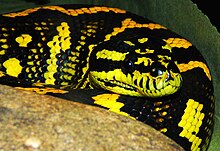
Morelia spilota cheynei, or the jungle carpet python, is a python subspecies found in the rainforests of Queensland, Australia. (Full article...) -
Image 12Sand viper may refer to:
- Vipera ammodytes, a.k.a. the nose-horned viper, a venomous species found in Europe through to the Balkans and parts of the Middle East.
- Cerastes vipera, a.k.a. the Avicenna viper, a venomous species found in the deserts of North Africa and the Sinai Peninsula.
- Heterodon, a.k.a. hog-nosed snakes, a genus of harmless colubrid species found in North America.
-
Image 13

Morelia spilota variegata, commonly known as
Torresian carpet python, Darwin carpet python or northwestern carpet python, is a subspecies of python found in New Guinea and Australia, smaller than the nominate subspecies Morelia spilota spilota and has a more restricted geographic range. (Full article...) -
Image 14

Morelia bredli is a species of non-venomous snake in the family Pythonidae. The species is endemic to Australia. No subspecies are recognized. Its common names include Bredl's python, the Centralian python, the Centralian carpet python, the central Australian carpet python, Bredl's carpet python, the central Australian Bredl's carpet python, and the central Bredl's carpet python. (Full article...) -
Image 15
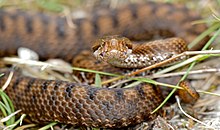
Vipera aspis is a viper species found in southwestern Europe.
Its common names include asp, asp viper, European asp, and aspic viper, among others. Like all other vipers, it is venomous. Bites from this species can be more severe than from the European adder, V. berus; not only can they be very painful, but approximately 4% of all untreated bites are fatal. The specific epithet, aspis, is a Greek word that means "viper." Five subspecies are currently recognized, including the nominate subspecies described here. (Full article...) -
Image 16
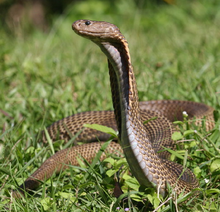
The Philippine cobra (Naja philippinensis) also called Philippine spitting cobra or northern Philippine cobra, is a stocky, highly venomous species of spitting cobra native to the northern regions of the Philippines. The Philippine cobra is called ulupong in Tagalog, carasaen in Ilocano. (Full article...) -
Image 17
Bungarus candidus, commonly known as the Malayan krait or blue krait, is a highly venomous species of snake. The blue krait is a member of the genus Bungarus and the family Elapidae. (Full article...) -
Image 18
Imantodes cenchoa, also known commonly as the blunthead tree snake, the neotropical blunt-headed tree snake, and the fiddle-string snake, is a species of mildly venomous, rear-fanged snake in the family Colubridae. The species is native to Mexico, Central America, and South America. (Full article...) -
Image 19
Pituophis is a genus of nonvenomous colubrid snakes, commonly referred to as gopher snakes, pine snakes, and bullsnakes, which are endemic to North America. (Full article...) -
Image 20

Crotalus concolor, commonly known as the midget faded rattlesnake, faded rattlesnake, and yellow rattlesnake, is a pit viper species found in the western United States. It is a small rattlesnake known for its faded color pattern. Like all other pit vipers, it is venomous. (Full article...) -
Image 21

The California kingsnake (Lampropeltis californiae) is a nonvenomous colubrid snake endemic to the western United States and northern Mexico, and is found in a variety of habitats. Due to ease of care and a wide range of color variations, the California kingsnake is one of the most popular snakes in captivity. (Full article...) -
Image 22

The dwarf beaked snake (Dipsina multimaculata), also called the western beaked snake, is a species of snake, which is endemic to southern Africa. It is in the monotypic genus Dipsina. (Full article...) -
Image 23

Protobothrops mangshanensis, commonly known as the Mangshan pit viper, Mt. Mang pit viper, or Mang Mountain pit viper, is a pit viper species endemic to Hunan and Guangdong provinces in China. No subspecies are currently recognized. This is a nocturnal pit viper that is also known as the ''Mangshan iron-head snake'', ''Chinese pit viper'', and the ''Ironhead viper''. They eat frogs, birds, insects, and small mammals. They have a white tail tip that they wiggle to mimic a grub so that prey comes into striking range—a behaviour known as caudal luring. The venom causes blood clotting and corrodes muscle tissue and can be fatal to humans if not treated. Unusually for vipers, P. mangshanensis is oviparous with the female laying clutches of 13–21 eggs which she will guard until they hatch. (Full article...) -
Image 24
The Atractaspididae (atractaspidids) are a family of venomous snakes found in Africa and the Middle East, commonly called mole vipers, stiletto snakes, or burrowing asps. Currently, 12 genera are recognized. (Full article...) -
Image 25
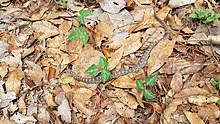
Crotalus intermedius gloydi is a subspecies of venomous pitviper in the family Viperidae. The subspecies is endemic to Mexico in the states of Oaxaca and Puebla. (Full article...)
Categories
Topics
Major extant reptile clades | |||||
|---|---|---|---|---|---|
| Lepidosauria | |||||
| Archelosauria |
| ||||
Associated Wikimedia
The following Wikimedia Foundation sister projects provide more on this subject:
-
Commons
Free media repository -
Wikibooks
Free textbooks and manuals -
Wikidata
Free knowledge base -
Wikinews
Free-content news -
Wikiquote
Collection of quotations -
Wikisource
Free-content library -
Wikiversity
Free learning tools -
Wiktionary
Dictionary and thesaurus
- What are portals?
- List of portals






